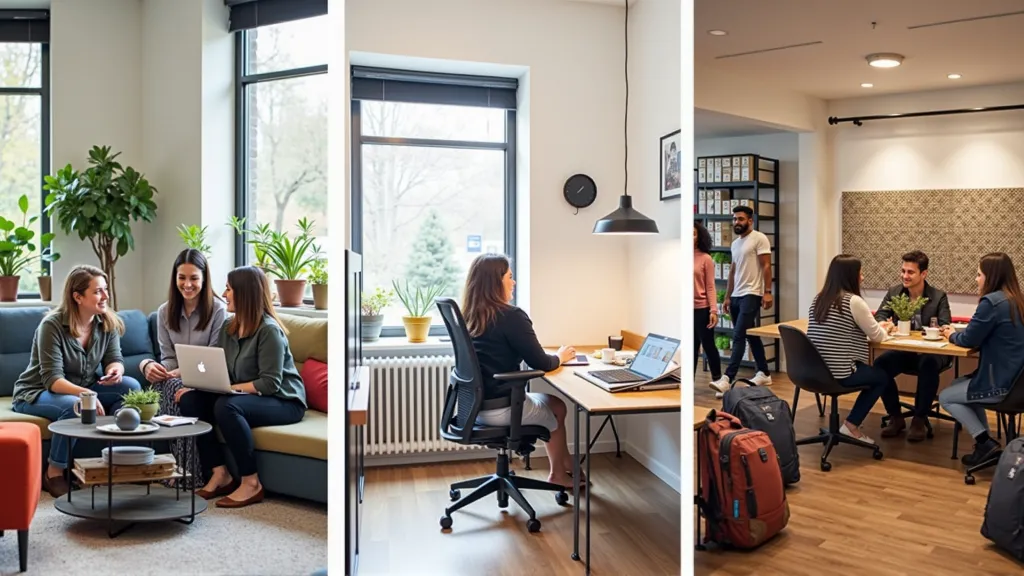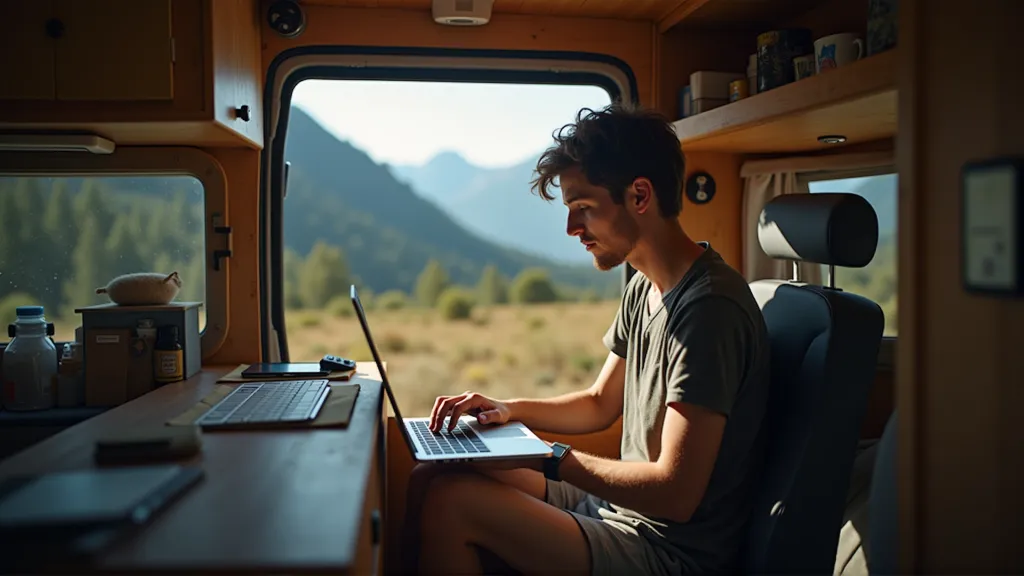In recent years, the way people work has changed. Many of you now work online while exploring the world. That’s why choosing the right place to live matters. Your accommodation can shape your daily routine. It affects your work, your social life, and your overall happiness. In this post, we dive into coliving vs apartments vs hostels for digital nomads. We’ll show you the pros and cons of each, so you can pick what fits your style. Explore our complete Digital Nomad Tips to Simplify Life on the Road, this guide digs deeper into how to choose your perfect home base.
Understanding the Digital Nomad Lifestyle and Accommodation Needs

Being a digital nomad means you need more than a cheap bed. You need reliable Wi-Fi, flexible lease options, and a solid workspace. You also want a community or some peace, depending on your mood. Every trip can last a few weeks to several months. That means your housing choice must adapt to changing plans.
What Makes Digital Nomad Housing Unique?
- Fast, reliable internet: You’ll lose work hours if your connection drops.
- Flexible terms: Short or rolling leases let you move quickly.
- Workspace and community: A desk, quiet zones, or shared areas help you focus. Many prefer a setup that lets you meet other travelers.
- Changing stay length: You might stay for days, weeks, or months. That affects costs, comfort, and packing needs.
What Digital Nomads Look for in a Place to Stay
- Productivity essentials
- Dedicated desk or coworking access.
- Strong Wi-Fi, backup options like mobile hotspots.
- Quiet spots for calls and deep focus.
- Social environment
- Networking opportunities vs. solitude.
- Events, meetups, or casual hangouts.
- Budget, comfort, and amenities
- Cost per month vs. what you get.
- Clean kitchen, laundry, and good mattress.
- Lifestyle factors
- Proximity to beaches, gyms, cafes, or coworking spaces.
- Local culture and ease of travel.
Finding the ideal spot means balancing work needs with lifestyle goals. Next, we’ll compare coliving, apartments, and hostels to see which remote work accommodations suit you best.
Coliving vs Apartments vs Hostels — Quick Comparison Table

Here’s a quick glance at how coliving, apartments, and hostels stack up across key factors. Use this when weighing coliving vs apartments vs hostels for digital nomads.
| Factor | Coliving | Apartments | Hostels |
|---|---|---|---|
| Cost | Mid-range: utilities often included | Variable: from budget to luxury | Low: dorm beds, shared bathrooms |
| Comfort | Modern common areas, furnished rooms | Fully private space, unfurnished | Basic rooms, minimal furnishings |
| Privacy | Private bedroom, shared living spaces | Full privacy, no shared spaces | Low privacy, shared dorms |
| Work Amenities | Dedicated co-work areas, strong Wi-Fi | You set up your own workspace | Limited: sometimes Wi-Fi but no desks |
| Community | Built-in social events, networking | Low unless you join groups | High: travelers mix in common areas |
| Flexibility | Flexible leases (weekly/monthly) | Longer leases (often 3+ months) | Nightly or weekly stays |
| Booking Platforms | NomadX, Outsite, Roam | Airbnb, Booking.com, local rentals | Hostelworld, Hostelbookers |
Use this table to match your needs. For example, if you want built-in events and fast Wi-Fi, coliving might be ideal. If you need full privacy and plan to stay long-term, an apartment could fit. If you’re budget-focused and love meeting new people, try a hostel.
What Each Option Offers

Coliving Spaces: Built for Digital Nomads
Coliving spaces cater directly to your remote work needs. You’ll find high-speed Wi-Fi and dedicated work areas in most setups. Many coliving properties offer private bedrooms with shared kitchens and living rooms. This mix gives you quiet spots to focus and common areas to network.
Key features:
- Workspace essentials: Ergonomic desks, good lighting, and fast internet keep you productive.
- Community events: Weekly meetups, skill-share sessions, and group dinners help you connect.
- All-in-one billing: Rent, utilities, and cleaning fees usually roll into one monthly payment.
These spots suit digital nomads who plan to stay a month or longer. If you value both work and social life, coliving strikes a balance. You won’t feel isolated, yet you can buckle down when deadlines hit.
Best for:
- Long stays of 1–6 months
- Solo professionals wanting built-in networking
- Those who thrive on community energy
Examples:
- BednDesk (Mallorca): Offers private rooms, coworking, and yoga classes.
- Outsite (Global): Stylish locations with reliable Wi-Fi and on-site coworking.
Apartments (Including Airbnb & Long-term Rentals)
Apartments give you a full, private home setup. You’ll have your own kitchen, living room, and living routine. This makes them ideal if you crave independence and consistency.
Pros:
- Full privacy: No roommates unless you choose them.
- Home-like comfort: Furnished or unfurnished options let you customize your space.
- Control over environment: You pick your own décor, schedule, and neighbors.
Cons:
- Variable work setups: Not every apartment has strong Wi-Fi or a quiet corner.
- Community gaps: Unless you join local meetups or coworking spaces, you might feel isolated.
Best for:
- Long-term stays (3+ months) where you unpack and settle in
- Couples or partners wanting shared space
- Privacy seekers who value a home-like routine
Tips for booking:
- Check for “Business-ready” tags on Airbnb to find apartments with desks and strong internet.
- Read guest reviews specifically about Wi-Fi speed and noise levels.
- Consider leasing platforms like NomadStays or Spotahome to find vetted digital nomad apartments.
Hostels: Social and Budget-Friendly
Hostels remain a classic choice for budget-focused digital nomads on short trips. You’ll pay very little per night or week, freeing up cash for travel, food, or experiences.
Highlights:
- Low cost: Shared dorms or private “pod” rooms cost a fraction of an apartment.
- Built-in community: Common rooms, game nights, and group tours make mingling natural.
- Easy booking: Use Hostelworld, Hostelbookers, or direct hostel sites.
Limitations:
- Work challenges: Dorms can be noisy, and Wi-Fi often lags during peak hours.
- Privacy trade-off: You share rooms, bathrooms, and sometimes even lockers.
- Short-term focus: Most people stay for a few days to a week, so networking beyond visitors can be tricky.
Best for:
- Extroverted nomads who love meeting new people
- Short stays (1–2 weeks) when you’re exploring a new city
- Travelers in a discovery phase who don’t need a permanent desk
Key Decision Factors: Which Option Matches Your Nomadic Lifestyle?

When it comes to choosing between coliving, apartments, and hostels, the “best” option depends on your unique needs. Here’s a breakdown of the five key factors digital nomads like you should weigh before making a decision.
1. Budget Considerations
Whether you’re bootstrapping a startup or working a remote 9–5, budget matters.
- Coliving: Typically costs more than hostels but includes utilities, cleaning, and sometimes coworking. Monthly rates range from $700 to $1,500+, depending on the location.
- Apartments: Prices vary widely. Airbnb and rentals can range from $800 to $2,000+ per month, especially in cities. Don’t forget hidden costs like deposits, utility bills, or coworking passes.
- Hostels: The most budget-friendly. Dorm beds often start at $10–$30/night, while private rooms go for $40–$80.
2. Work & Productivity Needs
Reliable internet and a quiet place to focus aren’t optional—they’re essential.
- Coliving: Designed for remote workers with dedicated desks, coworking areas, and strong Wi-Fi.
- Apartments: Hit or miss. Some have excellent setups, others may lack functional desks or decent lighting.
- Hostels: Not ideal for work. Expect noisy environments and inconsistent internet.
3. Community & Social Environment
Do you thrive on connection or need space to recharge?
- Coliving: Built-in community with events, shared meals, and group outings. Great for solo travelers.
- Apartments: Offers privacy, but you’ll need to seek out community at coworking spaces or meetups.
- Hostels: High-energy and social—but not always in a professional or focused way.
4. Location & Accessibility
Where you stay affects your experience just as much as how.
- Coliving & Hostels: Often located in trendy, central areas or close to coworking hubs.
- Apartments: Give more flexibility—urban apartments, beachside studios, or mountain cabins—but you might sacrifice walkability.
- All options: Consider your proximity to transport, cafes, grocery stores, and green spaces.
5. Comfort, Privacy, and Amenities
Little details can make or break your stay.
- Coliving: Offers a balance—private rooms with shared amenities like kitchens and lounges.
- Apartments: Top choice for comfort and privacy, especially if you need your own kitchen, bathroom, or quiet evenings.
- Hostels: Vary a lot. Shared bathrooms and lower sleep quality can be trade-offs for cost and connection.
Hybrid & Alternative Options Worth Considering

Not every digital nomad fits neatly into the coliving-apartment-hostel triangle. If you’re craving something a bit different—or more aligned with your values and lifestyle—these hybrid and alternative setups might catch your interest:
- Remote Work Retreats / Co-Housing: Temporary communities focused on connection and productivity. Think curated spaces like WiFi Tribe or Remote Year.
- House Sitting & Pet Sitting: Great if you enjoy quiet time and caring for animals. Platforms like TrustedHousesitters offer stays in exchange for your help.
- Van Life / RV Living: For the ultra-mobile explorer. Offers total flexibility but requires comfort with minimalism and logistics.
- All-in-One Platforms: Brands like Selina, Outsite, and Roam combine coliving, coworking, and travel-friendly perks in locations around the world.
Final Checklist: How to Choose the Right Option for You

Here’s a quick step-by-step checklist to help you narrow down your digital nomad housing:
- ✅ Define your length of stay (days, weeks, or months?)
- ✅ Clarify your work needs (quiet space, fast Wi-Fi, coworking?)
- ✅ Set a realistic budget, including hidden costs
- ✅ Assess your social preferences (community vs solitude)
- ✅ Prioritize must-have amenities (kitchen, laundry, workspace, AC)
Conclusion: The Right Accommodation = Better Nomad Life

Finding the right housing isn’t just about where you sleep—it shapes how well you live, work, and connect on the road. Whether you’re choosing between coliving vs apartments vs hostels for digital nomads, the best fit depends on your rhythm, budget, and lifestyle goals.
There’s no one-size-fits-all answer. The more you experiment, the better you’ll understand what works for you.
👉 Looking for more remote work tips? Check out Travipak’s digital nomad guides.
💬 What’s your go-to setup? Share it in the comments or tag us on social—we’d love to hear!



